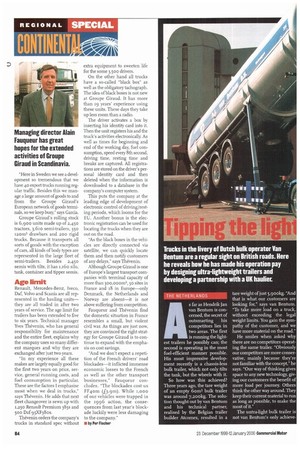Managing director Alain Fauqueur has great hopes for the extended activities of Groupe Giraud in Scandinavia.
Page 86

If you've noticed an error in this article please click here to report it so we can fix it.
"Here in Sweden we see a development so tremendous that we have 40 export trucks running regular traffic. Besides this we manage a large amount of goods to and from the Groupe Giraud's European network of goods terminals, so we keep busy," says Garcia.
Groupe Giraud's rolling stock is 6,900 units made up of 2,450 tractors, 3,610 semi-trailers, 55o rzom3 drawbars and zoo rigid trucks. Because it transports all sorts of goods with the exception of cars, all kinds of body types are represented in the large fleet of semi-trailers. Besides 2,450 semis with tilts, it has i,i6o silo, tank, container and tipper semis.
Age limit
Renault, Mercedes-Benz, Iveco, Daf, Volvo and Scania are all represented in the hauling units— they are all traded in after two years of service. The age limit for trailers has been extended to five to six years. Technical manager Yves Thevenin, who has general responsibility for maintenance and the entire fleet, explains why the company uses so many different marques and why they are exchanged after just two years.
"In my experience all these makes are largely eqiially good for the first two years on price, service, general running costs, and fuel consumption in particular. These are the factors I emphasise most when we deal in trucks," says Thevenin. He adds that next fleet changeover is sewn up with 1,25o Renault Premium 3855 and 5oo Daf 95XF38os.
Thevenin orders the company's trucks in standard spec without extra equipment to sweeten lily for the some 3,500 drivers.
On the other hand all trucks have a so-called "black box" as well as the obligatory tachograph. The idea of black boxes is not new at Groupe Giraud. It has more than 19 years' experience using these units. These days they take up less room than a radio.
The driver activates a box by inserting his identity card into it. Then the unit registers his and the truck's activities electronically. As well as times for beginning and end of the working day, fuel consumption, speed every 8th second, driving time, resting time and breaks are captured. All registrations are stored on the driver's personal identity card and then deleted when the information is downloaded to a database in the company's computer system.
This puts the company at the leading edge of development of electronic control of driving/resting periods, which looms for the EU. Another bonus is the electronic registration can be used for locating the trucks when they are out on the road.
"As the black boxes in the vehicles are directly connected via satellite, we can quickly locate them and then notify customers of any delays," says Thevenin.
Although Groupe Giraud is one of Europe's largest transport companies with terminal capacity of more than 300,00 am', 50 sites in France and 18 in Europe—only Denmark, the Netherlands and Norway are absent—it is not above suffering from competition.
Fauqueur and Thevenin find the domestic situation in France resembles a small, but violent civil war. As things are just now, they are convinced the right strategy for Groupe Giraud is to continue to expand with the emphasis on cost savings.
'And we don't expect a repetition of the French drivers' road blockades—it inflicted immense economic losses to the French as well as the other transport businesses," Fauqueur concludes. "The blockades cost us FF4om {,t3.9m). While r,000 of our vehicles were trapped in the 1996 action, the consequences from last year's blockade luckily were less damaging to the company."
• by Per Ascher




















































































































































